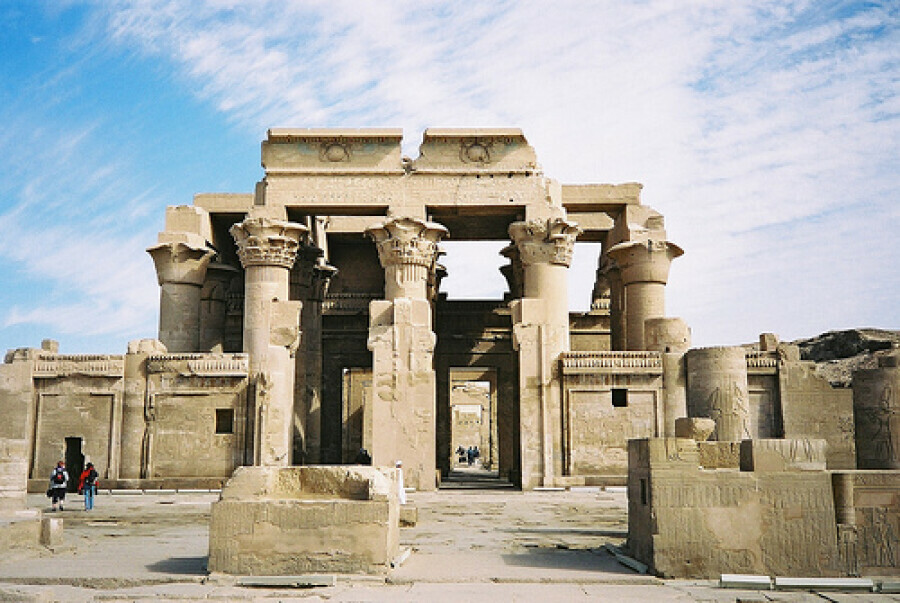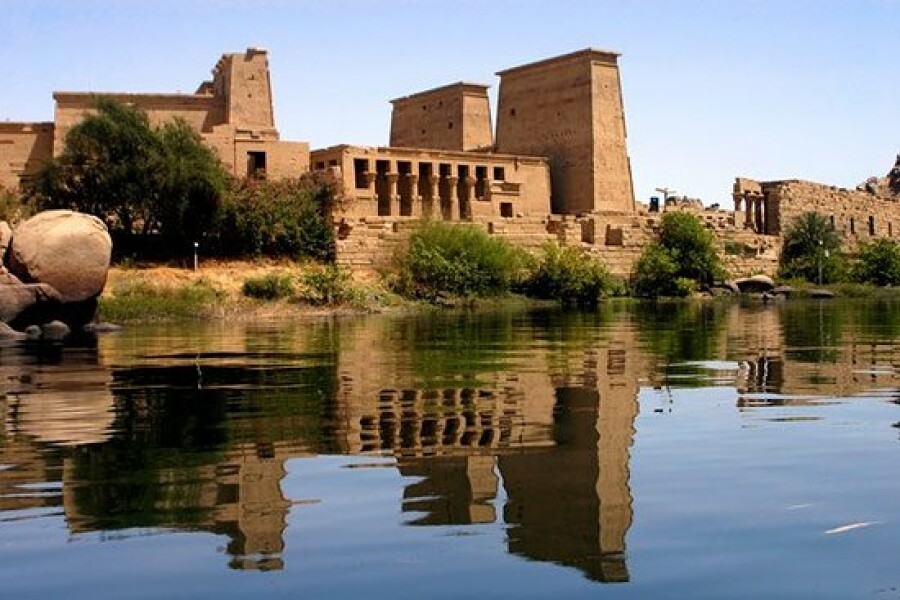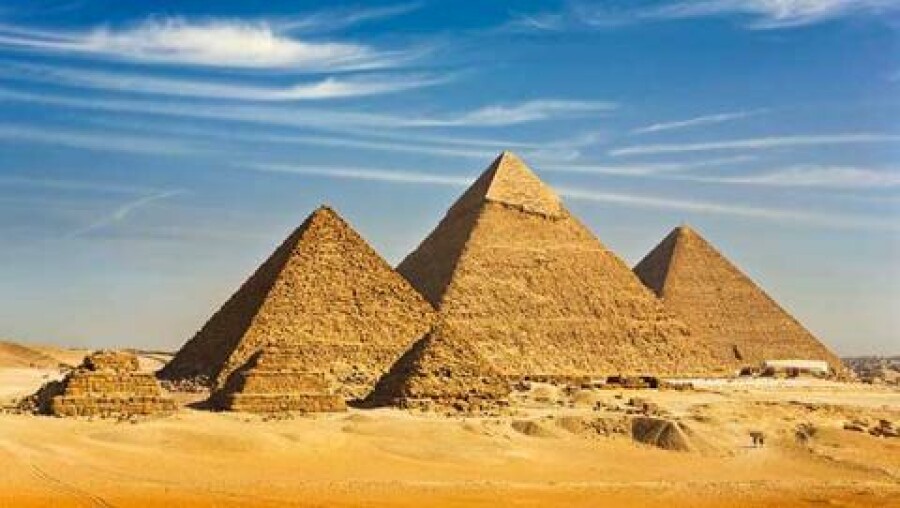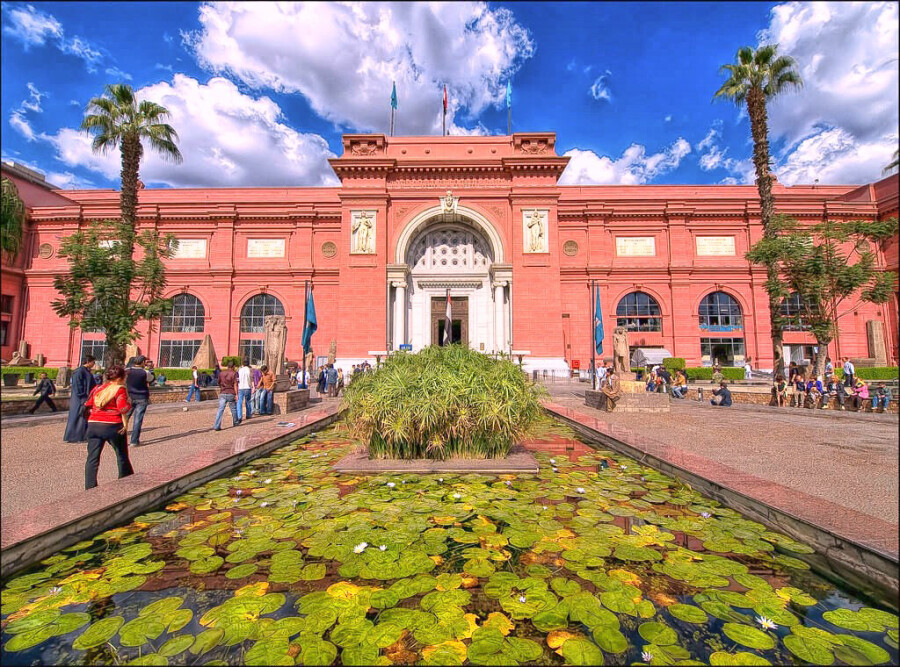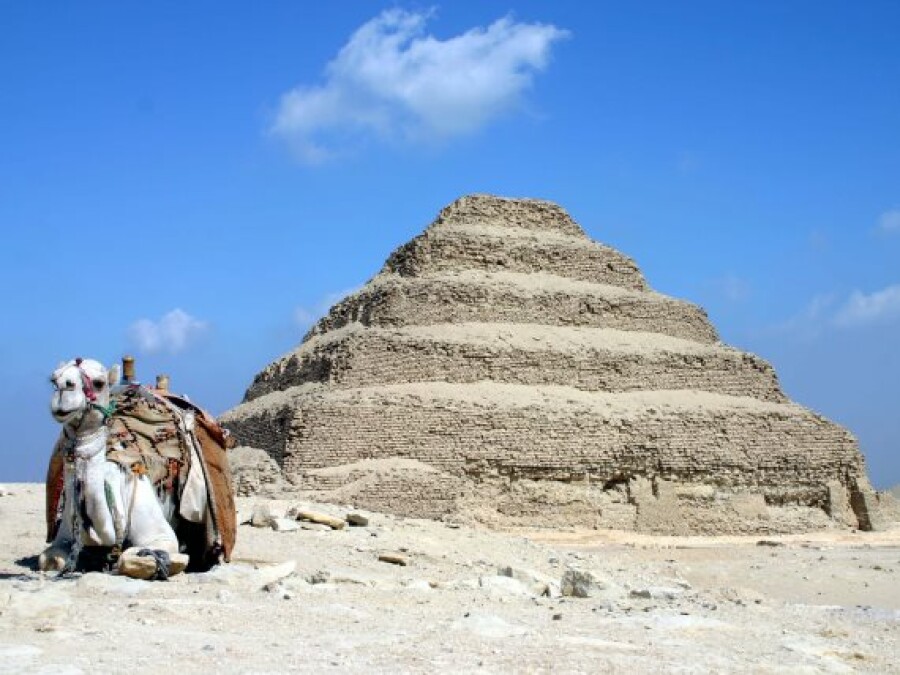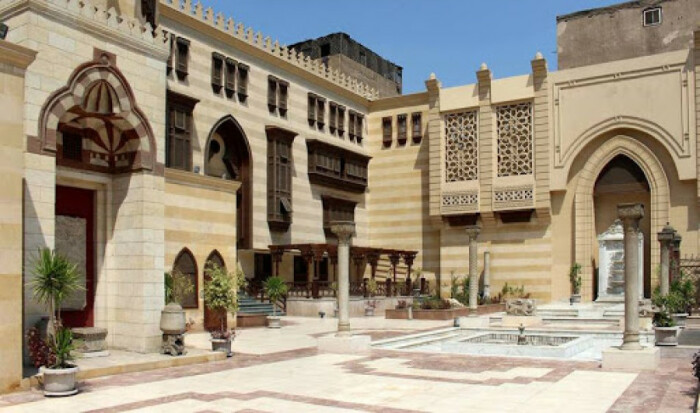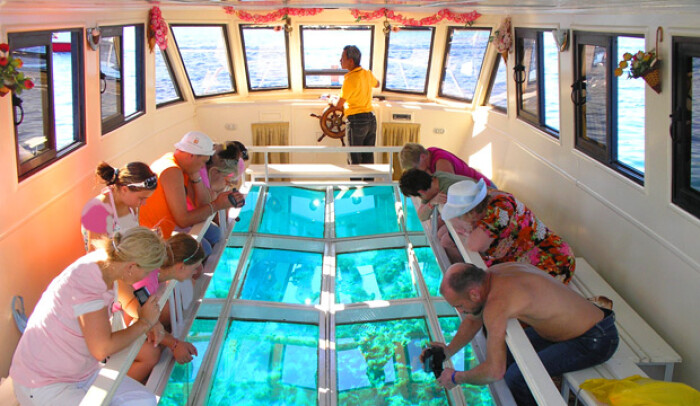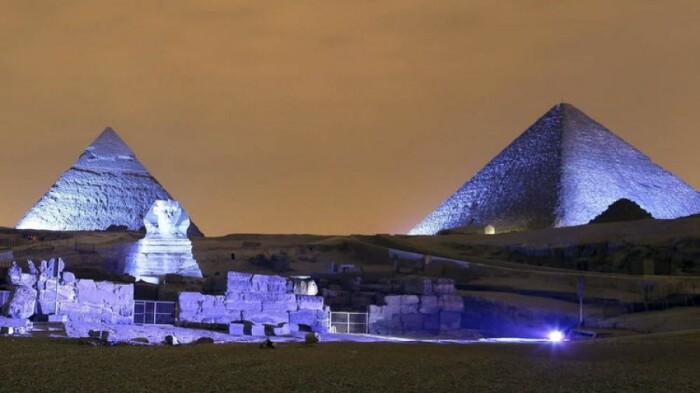Egypt -6 Nights
Aswan, Luxor, Cairo And Kom Ombo.
Excellent
0/5
Duration
7 Days
Type
Private
Run
Saturday, Monday, Wednesday
Location
Aswan, Luxor, Cairo And Kom Ombo
Overview
Have you dreamt ever seeing the great pyramid at Giza,the Egyptian museum,the step pyramid at Saqqara, the Coptic churches for the Holy family,the shining alabaster mosque in the citadel and neighbour Khan el-khalili at old Cairo? What about making a cruise on the longest river in the world"the Nile" from Aswan to luxor, visiting Philae temple,komombo temple, Karnak temple, luxor temple,Colossus of Memnon, Hatshepsut temple, Valley of the Kings including three magnificent tombs for the great Pharaohs,and Madinet Habu temple?
Itinerary
Day 1
Nile Dream Tours representative will assist you upon your arrival to Cairo Airport, transfer to the hotel and accommodation.
Day 2
In the morning you will meet by our tour guide and visit:
Giza plateau where the 4th dynasty pyramids were constructed Khufu (Cheops) pyramid, it is the oldest of the Seven Wonders of the Ancient World and the only one that stands until now, it is the most attractive monument on the plateau 146.59 meters high and its sides at the base reached 230.37 meters in length. The tilt of their faces was 52 degrees. It is the greatest monument in Egypt and has almost 2,300,000 stone blocks. As an Arab proverb says: "man fears time, but time fears pyramids."
Khafra (Khefern) pyramid is 136.4 meters high, each side measures 215.25 meters and the inclination of its faces is just over 53 degrees. Its estimated volume is more than 1.6 million cubic meters. On its vertex remains of the old original shiny limestone covering can still be seen.
The pyramid of Menkaura (Mykerinos) whose base measures 103.4 meters on each side and its original height was 65.5 meters, with a slope on all four sides of 51 degrees. It conserves at the base 16 courses of red granite that corresponded to the lower cladding of the monument. We will continue to visit the Valley temple and the Great Sphinx built by Pharaoh Khafra (Khefern) it is 73 meters long, and almost 20 meters high.
Saqqara necropolis, there you visit the Pyramid of Djoser the earliest stone building in Egypt built in the 27th century BC during the III Dynasty for the burial of Pharaoh. The pyramid structure rises above the plateau in a series of six stepped ‘mastabas" and was built in several stages, beginning with an initial square mastaba and that its plan was changed several times during the construction and finally was surrounded by a complex of dummy buildings enclosed within a niche limestone wall over 10 m high, all this was designed by the genius architect Imhotep.
After the tour, you will go to Giza train station , to take a vip train to Aswan
Giza plateau where the 4th dynasty pyramids were constructed Khufu (Cheops) pyramid, it is the oldest of the Seven Wonders of the Ancient World and the only one that stands until now, it is the most attractive monument on the plateau 146.59 meters high and its sides at the base reached 230.37 meters in length. The tilt of their faces was 52 degrees. It is the greatest monument in Egypt and has almost 2,300,000 stone blocks. As an Arab proverb says: "man fears time, but time fears pyramids."
Khafra (Khefern) pyramid is 136.4 meters high, each side measures 215.25 meters and the inclination of its faces is just over 53 degrees. Its estimated volume is more than 1.6 million cubic meters. On its vertex remains of the old original shiny limestone covering can still be seen.
The pyramid of Menkaura (Mykerinos) whose base measures 103.4 meters on each side and its original height was 65.5 meters, with a slope on all four sides of 51 degrees. It conserves at the base 16 courses of red granite that corresponded to the lower cladding of the monument. We will continue to visit the Valley temple and the Great Sphinx built by Pharaoh Khafra (Khefern) it is 73 meters long, and almost 20 meters high.
Saqqara necropolis, there you visit the Pyramid of Djoser the earliest stone building in Egypt built in the 27th century BC during the III Dynasty for the burial of Pharaoh. The pyramid structure rises above the plateau in a series of six stepped ‘mastabas" and was built in several stages, beginning with an initial square mastaba and that its plan was changed several times during the construction and finally was surrounded by a complex of dummy buildings enclosed within a niche limestone wall over 10 m high, all this was designed by the genius architect Imhotep.
After the tour, you will go to Giza train station , to take a vip train to Aswan
Day 3
Upon Arrival, to Aswan railway station, our guide will accompany you to visit; Philae Temples located now on The island of Aguilca between Aswan dam and the high dam constructed during the reign of Ptolemy II and completed by the Roman emperors. And it was dedicated to Goddess Isis, goddess of maternity and magic in the Egyptian mythology and was considered the mother of god Horus and the consort of God Osiris. Then you will be picked up back by the same way to your Nile cruise.
Day 4
Breakfast on board, free morning, visit the temple of Abu Simbel (optional)
At noon, navigation to Kom Ombo, visit Kom Ombo. Is an industrial town 45 km north of Aswan. Its classical name was Ombos, the temple is very unusual. It was dedicated to two triads of deities, each with their own associated chambers and sanctuaries. On the eastern side of the temple, the crocodile god Sobek is honored with his wife who is here named as Hathor and their son Khonsu. On the west side, Haroeris or ‘Horus the Elder’ is accompanied by his wife Hathor-ta-sent-nefert and their son Panebtawy. The main part of the temple was probably begun by Ptolemy VI Philometor, On the inside of the enclosure wall at the rear of the temple is a famous relief depicting surgical instruments
Navigation . Dinner and night on board
At noon, navigation to Kom Ombo, visit Kom Ombo. Is an industrial town 45 km north of Aswan. Its classical name was Ombos, the temple is very unusual. It was dedicated to two triads of deities, each with their own associated chambers and sanctuaries. On the eastern side of the temple, the crocodile god Sobek is honored with his wife who is here named as Hathor and their son Khonsu. On the west side, Haroeris or ‘Horus the Elder’ is accompanied by his wife Hathor-ta-sent-nefert and their son Panebtawy. The main part of the temple was probably begun by Ptolemy VI Philometor, On the inside of the enclosure wall at the rear of the temple is a famous relief depicting surgical instruments
Navigation . Dinner and night on board
Day 5
Breakfast on board. free morning Sailing to Luxor, and after lunch on board, visit;
The East Bank. The Egyptians believed that towards the end of the annual agricultural cycle the gods and the earth became exhausted and required a fresh input of energy from the chaotic energy of the cosmos. To accomplish this magical regeneration the Opet festival was held yearly the procession began at Karnak and ended at Luxor Temple
Karnak Temple, a city of temples built over 2,000 years It is the largest religious building ever made, covering about 1.5 km by 0.8 km could hold ten average European cathedrals. The great temple at the heart of Karnak is so big that St Peter’s, Milan, and Notre Dame Cathedrals would fit within its walls. with the largest number of pylons in all the Egyptian temples dedicated to the sacred triad of Thebes Gods, Amun, his wife Mut, and their son Khonsu
Luxor Temple Lying at the other end of Thebes connected with Karnak by the avenue of sphinxes the temple was built by Amenhotep III completed by Tutankhamun and Horemheb from the XVIII dynasty and finally, Ramses II from the XIX dynasty added the first pylon later the sanctuary was reconstructed by Alexander the Great.
After the tour, you go back to the cruise to have dinner and stay on board overnight in Luxor
The East Bank. The Egyptians believed that towards the end of the annual agricultural cycle the gods and the earth became exhausted and required a fresh input of energy from the chaotic energy of the cosmos. To accomplish this magical regeneration the Opet festival was held yearly the procession began at Karnak and ended at Luxor Temple
Karnak Temple, a city of temples built over 2,000 years It is the largest religious building ever made, covering about 1.5 km by 0.8 km could hold ten average European cathedrals. The great temple at the heart of Karnak is so big that St Peter’s, Milan, and Notre Dame Cathedrals would fit within its walls. with the largest number of pylons in all the Egyptian temples dedicated to the sacred triad of Thebes Gods, Amun, his wife Mut, and their son Khonsu
Luxor Temple Lying at the other end of Thebes connected with Karnak by the avenue of sphinxes the temple was built by Amenhotep III completed by Tutankhamun and Horemheb from the XVIII dynasty and finally, Ramses II from the XIX dynasty added the first pylon later the sanctuary was reconstructed by Alexander the Great.
After the tour, you go back to the cruise to have dinner and stay on board overnight in Luxor
Day 6
Breakfast on board and Visit;
Valley of the Kings is one of the oldest Royal burial places in all over the world. It consists of more than 60 rock-cut tombs carved out of a big mountain which looks like a huge natural Pyramid overlooking the Nile on the west bank of Luxor, more than a third of this number of tombs used for burying the great pharaohs ruled Egypt from the 16th century to 11th century B.C which considered the glamorous days of Ancient Egypt known as the New Kingdom period (18th, 19th and 20th dynasties), such as the famous pharaohs Thotmosis lll, Sity l Ramsis ll, Ramsis lll, etc. Each tomb consists of 3 or 4 large corridors decorated with bright and colorful scenes, paintings and carvings representing philosophical ideas and future vision of the Hereafter, which explained and illustrated in 9 Holly books such as the book of deads, the book of caverns etc..., those large corridors end by the most important point of the tomb which is the burial chamber supposedly to have the most valuable objects of the treasure buried around the Pharaoh's mummy, as well we can see a very large painting of goddess Nut the goddess of the Sky and the journey of day and night, some of these burial chambers still has the sarcophagus you hardly believe it is cut out of single piece of granite brought from Aswan quarries 130 miles south of Luxor and taken dawn more than 300fts into the mountain, So many excavators worked in Valley of the Kings, such as Howard Carter who discovered the discovery of the discoveries of the 20th century which is the intact tomb of King Tut Ankh Amon occurred in 4th of November 1922.
The Mortuary Temple of Queen Hatshepsut is one of the best architectural buildings; it consists of three levels connected to each other and has different scenes on its walls that represent the queen's divine birth and commercial expedition to the land of Punt. The temple is mainly dedicated to worshiping the god Ammon-Ra.After that you will visit Medina Habu complex here Ramses III constructed his larger memorial temple the whole temple complex was surrounded by a massive fortified enclosure wall, with an unusual gateway at the eastern entrance, known as the pavilion gate. This structure, a copy of Syrian Migdal fortresses is something you would not expect to see in Egypt
The Colossi of Memnon, are two statues that represent Pharaoh Amenhotep III in a seated position in front of his funeral temple.
Transfer to Luxor railawy station to get your train and go back Cairo
Valley of the Kings is one of the oldest Royal burial places in all over the world. It consists of more than 60 rock-cut tombs carved out of a big mountain which looks like a huge natural Pyramid overlooking the Nile on the west bank of Luxor, more than a third of this number of tombs used for burying the great pharaohs ruled Egypt from the 16th century to 11th century B.C which considered the glamorous days of Ancient Egypt known as the New Kingdom period (18th, 19th and 20th dynasties), such as the famous pharaohs Thotmosis lll, Sity l Ramsis ll, Ramsis lll, etc. Each tomb consists of 3 or 4 large corridors decorated with bright and colorful scenes, paintings and carvings representing philosophical ideas and future vision of the Hereafter, which explained and illustrated in 9 Holly books such as the book of deads, the book of caverns etc..., those large corridors end by the most important point of the tomb which is the burial chamber supposedly to have the most valuable objects of the treasure buried around the Pharaoh's mummy, as well we can see a very large painting of goddess Nut the goddess of the Sky and the journey of day and night, some of these burial chambers still has the sarcophagus you hardly believe it is cut out of single piece of granite brought from Aswan quarries 130 miles south of Luxor and taken dawn more than 300fts into the mountain, So many excavators worked in Valley of the Kings, such as Howard Carter who discovered the discovery of the discoveries of the 20th century which is the intact tomb of King Tut Ankh Amon occurred in 4th of November 1922.
The Mortuary Temple of Queen Hatshepsut is one of the best architectural buildings; it consists of three levels connected to each other and has different scenes on its walls that represent the queen's divine birth and commercial expedition to the land of Punt. The temple is mainly dedicated to worshiping the god Ammon-Ra.After that you will visit Medina Habu complex here Ramses III constructed his larger memorial temple the whole temple complex was surrounded by a massive fortified enclosure wall, with an unusual gateway at the eastern entrance, known as the pavilion gate. This structure, a copy of Syrian Migdal fortresses is something you would not expect to see in Egypt
The Colossi of Memnon, are two statues that represent Pharaoh Amenhotep III in a seated position in front of his funeral temple.
Transfer to Luxor railawy station to get your train and go back Cairo
Day 7
Upon arrival to Cairo you will visit the Egyptian Museum of Antiquities which was built in 1902, and it exhibits a large number of items and treasures (exceeding 170,000 masterpieces) dating from the Prehistoric Period to the end of the Roman era, arranged in chronological order, exhibited in 42 rooms on the ground floor contains the largest of the exhibits, such as a massive statue pair of Amenhotep III and his wife Tiye, the colossal statues of Ramses II, the super famous pieces like the Narmer Palette, diorite statue of Khafre, bedroom furniture of Queen Hetepheres and the exhibits of the Amarna collection which include a colossal statue of the ‘heretic’ king Akhenaton. The upper floor there are 47 rooms housing about 3000 pieces of the treasure of Tutankhamun the boy-king’s tomb, discovered by Howard Carter in 1922, including the shrines and tomb furniture the famous gold mask and sarcophagi.
Then will go to visit “The Citadel of Saladin Al Ayouby”. It was built in the 12th century to fortify Cairo against the Crusaders. The citadel was used as the seat of the king and his government in Egypt for many centuries and many dynasties including the Ayyubids, the Mamluks, and even some Ottomans ruled over Egypt from the Citadel and the Great Alabaster Mosque of Mohamed Ali Pasha which stands proudly on the highest point inside the courtyard of the Citadel of Saladin. It’s one of the landmarks in Cairo with its huge space, the beautiful decorations on its walls, and its remarkable domes and minarets.
Then will proceed to old Cairo where The Holy Family arrived, and they took refuge in a cave beneath the ground, adjacent to the fortress of Babylon, and they lived in this cave for three months. Eventually, this cave was turned into a small church, and another larger church was built above it. known as Abu Serga Church. This is a famous church that is visited by many people from around the world, as they seek the blessings of the place where the Holy Family lived for some time. It is considered one of the oldest churches that were built in Egypt. Adjacent to this church is a church similar in antiquity, namely, the Moualaqa Church or the ‘Hanging Church’. This church is named the ‘hanging church’ because of the way that it is situated – over the gatehouse of Babylon’s Roman And ending Coptic Cairo tour with a visit to the "Jewish Synagogue of Ben Ezra" which gained its importance from its Genizah (storeroom) was found during the 19th century containing a treasure of abandoned Hebrew secular and sacred manuscripts.
After lunch in a local restaurant you go to the famous souq and bazaar of Khan el Khalili one of Cairo's main attractions for tourists and Egyptians alike. It is also home to many Egyptian artisans and workshops involved in the production of traditional crafts and souvenirs. The Khan Khalili today is occupied by local merchants and traders and is significantly geared towards tourists where it is considered as one of the most popular souqs in the region. Shops typically sell souvenirs, and jewelry, many craftsmen' workshops manufacturing some products sold here In addition to shops, there are several coffee-houses, restaurants, and street food vendors distributed throughout the market. The coffee shops are generally small and quite traditional, serving Arabic coffee. One of the oldest and most famous coffee houses is El Fishawi's, established in 1773.
After finish, the tour will be transferred to Cairo airport
Then will go to visit “The Citadel of Saladin Al Ayouby”. It was built in the 12th century to fortify Cairo against the Crusaders. The citadel was used as the seat of the king and his government in Egypt for many centuries and many dynasties including the Ayyubids, the Mamluks, and even some Ottomans ruled over Egypt from the Citadel and the Great Alabaster Mosque of Mohamed Ali Pasha which stands proudly on the highest point inside the courtyard of the Citadel of Saladin. It’s one of the landmarks in Cairo with its huge space, the beautiful decorations on its walls, and its remarkable domes and minarets.
Then will proceed to old Cairo where The Holy Family arrived, and they took refuge in a cave beneath the ground, adjacent to the fortress of Babylon, and they lived in this cave for three months. Eventually, this cave was turned into a small church, and another larger church was built above it. known as Abu Serga Church. This is a famous church that is visited by many people from around the world, as they seek the blessings of the place where the Holy Family lived for some time. It is considered one of the oldest churches that were built in Egypt. Adjacent to this church is a church similar in antiquity, namely, the Moualaqa Church or the ‘Hanging Church’. This church is named the ‘hanging church’ because of the way that it is situated – over the gatehouse of Babylon’s Roman And ending Coptic Cairo tour with a visit to the "Jewish Synagogue of Ben Ezra" which gained its importance from its Genizah (storeroom) was found during the 19th century containing a treasure of abandoned Hebrew secular and sacred manuscripts.
After lunch in a local restaurant you go to the famous souq and bazaar of Khan el Khalili one of Cairo's main attractions for tourists and Egyptians alike. It is also home to many Egyptian artisans and workshops involved in the production of traditional crafts and souvenirs. The Khan Khalili today is occupied by local merchants and traders and is significantly geared towards tourists where it is considered as one of the most popular souqs in the region. Shops typically sell souvenirs, and jewelry, many craftsmen' workshops manufacturing some products sold here In addition to shops, there are several coffee-houses, restaurants, and street food vendors distributed throughout the market. The coffee shops are generally small and quite traditional, serving Arabic coffee. One of the oldest and most famous coffee houses is El Fishawi's, established in 1773.
After finish, the tour will be transferred to Cairo airport
Included/Excluded
- Meet and greet service by our representatives upon your airport arrival.
- Transfers in private vehicle with air conditioning.
- 2 Vip train tickets
- English-speaking tour guide during your excursions
- Excursions according to the itinerary.
- Accommodation in Cairo for 1 night, including daily breakfast
- Accommodation on board Nile cruise 3 nights, on full board
- This itinerary could be changed in order according to the circumstances of service not to be canceled
- Taxes
- Transfers in private vehicle with air conditioning.
- 2 Vip train tickets
- English-speaking tour guide during your excursions
- Excursions according to the itinerary.
- Accommodation in Cairo for 1 night, including daily breakfast
- Accommodation on board Nile cruise 3 nights, on full board
- This itinerary could be changed in order according to the circumstances of service not to be canceled
- Taxes
- International airfare to Egypt
- Entry Visa to Egypt
- Main Entrance Fees
- Personal spending.
- Drinks
- Tipping.
- Optional Activities.
- Anything not mentioned above.
- Entry Visa to Egypt
- Main Entrance Fees
- Personal spending.
- Drinks
- Tipping.
- Optional Activities.
- Anything not mentioned above.

